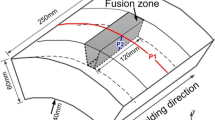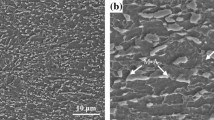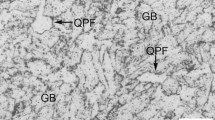Abstract
X70 pipeline steel is butt welded by fully automatic welding at 25° slope, and the characteristic information of welding process is collected. A 3D transient heat and mass transfer model of weld pool is established. This model was verified by means of the shape of the weld pool and the two-dimensional shape of the weld, and then, the flow field of the fully automatic welding process under steep slope conditions was simulated to clarify the mechanism of the lack of fusion defect. The results show that the welding arc is deflected when it stays on both side walls of the groove. The slope makes the liquid metal tend to gather at the lower groove. When gravity plays a leading role in the flow of the molten pool, some liquid metal begins to flow out from the lower groove to the front end, resulting in an overflow phenomenon. The generation of overflow phenomenon and arc deflection cause the formation of a “void zone” at the structure mutation position in front of the groove. In the welding process, the liquid metal tends to flow to the side walls for heat transfer under various thermal effects, and forms a large range of eddy current at the side walls. This has a positive effect on sidewall melting. In addition, the effect of surface tension at the lower groove is more obvious than that at the upper groove, and the trend of upward flow along the side wall is stronger, so it is difficult for the high-temperature liquid metal in the arc center to flow to the “void area” located at the bottom of the side wall of the lower groove. Therefore, the bottom of the lower groove is more likely to cause lack of fusion defect.



















Similar content being viewed by others
Data availability
The data supporting the article content is presented in the article.
References
Wang XJ, Liu K (2020) Difficulties and countermeasures for quality control of mountain pipeline welding. Electr Weld Mach 50(2):76–78
Ma YC (2016) The impact of “through wind” on the welding quality of pipelines in mountainous areas. Weld Technol 45(9):4–5
Zhao W, Jiang W, Zhang H, Han B, Jin H, Gao Q (2021) 3D finite element analysis and optimization of welding residual stress in the girth joints of X80 steel pipeline. J Manuf Process 66:166–178
Girth SY (2017) Welding on oil and gas pipeline projects in China. In: Advances in Materials Processing: Proceedings of Chinese Materials Conference 2017 18th. Springer, Singapore, pp 1143–1154
Zeng H, Wang C, Yang X, Wang X, Liu R (2014) Automatic welding technologies for long-distance pipelines by use of all-position self-shielded flux cored wires. Nat Gas Ind B 1(1):113–118
Dong W, Lu S, Li D, Li Y (2011) GTAW liquid pool convections and the weld shape variations under helium gas shielding. Int J Heat Mass Tran 54(7-8):1420–1431
Zhao L, Tsukamoto S, Arakane G, Sugino T, DebRoy T (2011) Influence of oxygen on weld geometry in fibre laser and fibre laser-GMA hybrid welding. Sci Technol Weld Join 16(2):166–173
Cho DW, Lee SH, Na SJ (2013) Characterization of welding arc and weld pool formation in vacuum gas hollow tungsten arc welding. J Mater Process Technol 213(2):143–152
Wang J, Zhu J, Zhang C, Xu G, Li WH (2016) Effect of arc swing parameters on narrow gap vertical GMA weld formation. ISIJ Int 56(5):844–850
Xu WH, Lin SB, Fan CL, Zhuo XQ, Yang CL (2014) Statistical modelling of weld bead geometry in oscillating arc narrow gap all-position GMA welding. Int J Adv Manuf Technol 72:1705–1716
Cho DW, Na SJ, Cho MH, Lee JS (2013) A study on V-groove GMAW for various welding positions. J Mater Process Tech 213(9):1640–1652
He Y, Tang X, Zhu C, Lu F, Cui H (2017) Study on insufficient fusion of NG-GMAW for 5083 Al alloy. Int J Adv Manuf Technol 92:4303–4313
Meng Y, Li G, Gao M, Zhang C, Zeng X (2019) Formation and suppression mechanism of lack of fusion in narrow gap laser-arc hybrid welding. Int J Adv Manuf Tech 100:2299–2309
Cho DW, Na SJ (2015) Molten pool behaviors for second pass V-groove GMAW. Int J Heat Mass Tran 88:945–956
Yang D (2018) Numerical simulation of high strength steel bottom weld forming by vertical-up swing double-side MAG. Dissertation, Harbin Institute of Technology
Wu CS, Zhang HT, Chen J (2017) Numerical simulation of keyhole behaviors and fluid dynamics in laser-gas metal arc hybrid welding of ferrite stainless steel plates. J Manuf Process 25:235–245
Meng X, Qin G, Zou Z (2016) Sensitivity of driving forces on molten pool behavior and defect formation in high speed gas tungsten arc welding. Int J Heat Mass Tran 107:1119–1128
Xu G, Cao Q, Hu Q, Zhang W, Liu P, Du B (2016) Modelling of bead hump formation in high speed gas metal arc welding. Sci Technol Weld Joi 21(8):700–710
Voller VR, Prakash C (1987) A fixed grid numerical modelling methodology for convection-diffusion mushy region phase-change problems. Int J Heat Mass Tran 30(8):1709–1719
Yuan S, Liu WJ, Li LY, Jiang X (2018) Heat source model and temperature field simulation for the fusion of side wall welded by weaving arc narrow gap MAG welding. Trans China Weld Inst 39(12):95–99
Lan H, Zhang H, Chen A, Chen S (2015) Numerical simulation on dynamic process and thermal physical properties of narrow gap MAG vertical welding. Trans China Weld Inst 36(7):77–82
Sahoo P, Debroy T, Mcnallan MJ (1988) Surface tension of binary metal-surface active solute systems under conditions relevant to welding metallurgy. Metall Trans B 19(3):483–491
Wu CS (1988) Fluid Flow and Heat Transfer in GMA Weld Pools. Weld J 67(3):70s–75s
Meng X, Qin G, Zou Z (2018) Characterization of molten pool behavior and humping formation tendency in high speed gas tungsten arc welding. Int J Heat Mass Tran 117:508–516
Funding
This work is supported by the Key Scientific Research Projects of PipeChina Group, grant no. CLZB20211; the National Key R&D Program of China, grant no. 2021YFA1000103; and the Key Research and Development Plan of Shandong Province, grant no. 2020CXGC010207 and 2022CXGC010202.
Author information
Authors and Affiliations
Contributions
Liying Li: conceptualization, methodology, writing — review and editing. Jinqiu Fu: writing — original draft, data curation, numerical simulation. Yungang Yao: numerical simulation, writing — original draft, formal analysis. Xuejun Wang: welding process data acquisition, funding acquisition. Kai Liu: welding process data acquisition. Tao Han: conceptualization, methodology, supervision. Bin Han: conceptualization, supervision, funding acquisition.
Corresponding author
Ethics declarations
Ethics approval
The authors confirm that they have abided by the publication ethics and state that this work is original and has not been used for publication anywhere before.
Consent to participate
The authors are willing to participate in journal promotions and updates.
Consent for publication
The authors give consent to the journal regarding the publication of this work.
Conflict of interest
The authors declare no competing interests.
Additional information
Publisher’s note
Springer Nature remains neutral with regard to jurisdictional claims in published maps and institutional affiliations.
Rights and permissions
Springer Nature or its licensor (e.g. a society or other partner) holds exclusive rights to this article under a publishing agreement with the author(s) or other rightsholder(s); author self-archiving of the accepted manuscript version of this article is solely governed by the terms of such publishing agreement and applicable law.
About this article
Cite this article
Li, L., Fu, J., Yao, Y. et al. Generation mechanism of lack of fusion in X70 steel welded joint by fully automatic welding under steep slope conditions based on numerical simulation of flow field. Int J Adv Manuf Technol 126, 4055–4072 (2023). https://doi.org/10.1007/s00170-023-11386-1
Received:
Accepted:
Published:
Issue Date:
DOI: https://doi.org/10.1007/s00170-023-11386-1




